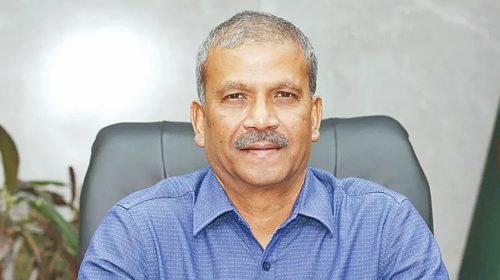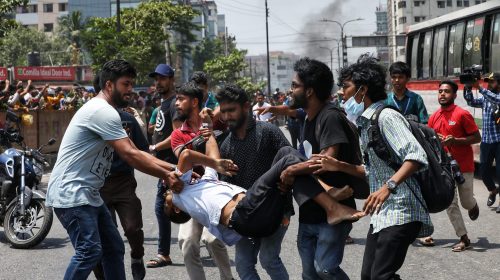Children’s hand foot and mouth disease is increasing in Chittagong. However, many people are confusing it with chicken pox. As a result, they are giving antibiotics, which have overcome the children more. However, if only the rules are followed, this disease can be cured within a week to 10 days.
15-20 children patients are coming to the outpatient department of Chittagong Medical College Hospital every day with the symptoms of this disease. Being essentially a contagious disease, this disease spreads rapidly from one child to another.
Doctors say, this infectious disease can affect children as well as adults. It is similar to hydrops. Many parents are confused about this. Therefore, if symptoms appear, do not take antibiotics and consult a doctor.
Ratna Begum, a resident of the city’s GEC area, saw rash on the body of one-and-a-half-year-old child Dawood for a few days. At first he thought it was spring fever, but later found that the rash had grown. On seeing an MBBS doctor next door, he first referred it as chicken pox and prescribed some medicine. After taking the medicine for a week, the child developed fever and cough.
Later, when I was seen at Chittagong Medical’s pediatric outpatient department, the doctor said that it was actually ‘hand foot and mouth disease’.
It is known that 15 to 20 child patients are coming to Chittagong Medical’s outpatient department every day. Hand foot and mouth disease mainly affects the hands, feet, mouth and tongue.
Chittagong Medical Department’s pediatric resident doctor Dr. Saiful Islam said, “Hand foot and mouth disease and Jalbasant are both viral diseases. The difference between the two is that hand foot and mouth disease has a sore throat, fever and loss of appetite. A few days later, the mouth and tongue develop a pus-like rash. So that it can be painful, it can be difficult to eat. This disease causes pink, red or black raised bumps on the hands and feet depending on the color of the skin. Later it becomes a watery rash. Most often the rash appears on the hands, feet and tongue, but sometimes on the thighs or buttocks.’
Dr. Saiful Islam also said, ‘This disease is mainly caused by a type of virus called Coxsackie. It can be transmitted to others through infected child’s nasal discharge, saliva, blister water, sneeze and cough, and even through the stool of an infected child. Symptoms of the disease appear four to six days after the virus enters the child’s body. However, if the situation is complicated, water deficiency may occur in the child’s body. Then the child may need to be hospitalized.
Pediatrician Dr. Basna Muhuri said, “There is no special treatment for this disease nor does it need it.” It usually gets better within 7 to 10 days. In normal care, food, especially water or drink should be given sufficiently, so that urination is done properly. Foods rich in vitamin-C, especially fruit juices, can reduce mouth pain.
He also said, “If there is a fever, a certain amount of paracetamol can be given. But giving aspirin is not right. No antibiotic, antiviral or antifungal medication is required. However, to prevent this disease, children should be taught to wash their hands well. The discipline of sneezing and coughing should be followed. House, floor, toys should be kept clean. The practice of putting hands in the mouth should be eliminated and crowds should be avoided.
Children’s hand foot and mouth disease is increasing in Chittagong. However, many people are confusing it with chicken pox. As a result, they are giving antibiotics, which have overcome the children more. However, if only the rules are followed, this disease can be cured within a week to 10 days.
15-20 children patients are coming to the outpatient department of Chittagong Medical College Hospital every day with the symptoms of this disease. Being essentially a contagious disease, this disease spreads rapidly from one child to another.
Doctors say, this infectious disease can affect children as well as adults. It is similar to hydrops. Many parents are confused about this. Therefore, if symptoms appear, do not take antibiotics and consult a doctor.
Ratna Begum, a resident of the city’s GEC area, saw rash on the body of one-and-a-half-year-old child Dawood for a few days. At first he thought it was spring fever, but later found that the rash had grown. On seeing an MBBS doctor next door, he first referred it as chicken pox and prescribed some medicine. After taking the medicine for a week, the child developed fever and cough.
Later, when I was seen at Chittagong Medical’s pediatric outpatient department, the doctor said that it was actually ‘hand foot and mouth disease’.
It is known that 15 to 20 child patients are coming to Chittagong Medical’s outpatient department every day. Hand foot and mouth disease mainly affects the hands, feet, mouth and tongue.
Chittagong Medical Department’s pediatric resident doctor Dr. Saiful Islam said, “Hand foot and mouth disease and Jalbasant are both viral diseases. The difference between the two is that hand foot and mouth disease has a sore throat, fever and loss of appetite. A few days later, the mouth and tongue develop a pus-like rash. So that it can be painful, it can be difficult to eat. This disease causes pink, red or black raised bumps on the hands and feet depending on the color of the skin. Later it becomes a watery rash. Most often the rash appears on the hands, feet and tongue, but sometimes on the thighs or buttocks.’
Dr. Saiful Islam also said, ‘This disease is mainly caused by a type of virus called Coxsackie. It can be transmitted to others through infected child’s nasal discharge, saliva, blister water, sneeze and cough, and even through the stool of an infected child. Symptoms of the disease appear four to six days after the virus enters the child’s body. However, if the situation is complicated, water deficiency may occur in the child’s body. Then the child may need to be hospitalized.
Pediatrician Dr. Basna Muhuri said, “There is no special treatment for this disease nor does it need it.” It usually gets better within 7 to 10 days. In normal care, food, especially water or drink should be given sufficiently, so that urination is done properly. Foods rich in vitamin-C, especially fruit juices, can reduce mouth pain.
He also said, “If there is a fever, a certain amount of paracetamol can be given. But giving aspirin is not right. No antibiotic, antiviral or antifungal medication is required. However, to prevent this disease, children should be taught to wash their hands well. The discipline of sneezing and coughing should be followed. House, floor, toys should be kept clean. The practice of putting hands in the mouth should be eliminated and crowds should be avoided.






















